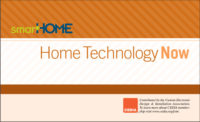How often do you work with architects, builders and interior designers? Often it is hard to explain how different technologies will impact a project. Working with your industry partners in the planning stages of a project just got easier.
CEDIA, CEA and InfoComm released ANSI Standard J-STD-710 audio, video and control architectural drawing symbols. Creating this particular standard has taken years and countless hours, but the end result is pretty spectacular.
This new standard defines a common set of blueprint icons that represents all facets of pre-wire and installation of electronic systems, products and devices in residential and commercial environments.
With the standard, designers now have a visual tool to show where devices will be located and the flexibility of anchoring legend-based descriptions with the symbols. Communicating full device and technology placement up front in the process can save headaches later on; therefore, these symbols are designed to save time and money on a project and ensure that everyone is on the same page.
Dave Pedigo, CEDIA senior director of learning & emerging trends, has been working on this project for quite some time. We caught up with him to learn more about what makes this standard so special.
Why is now the right time for the standards to be released to market?
There has been a need for these symbols for many years, but creating the standard has been a lengthy process. Gaining consensus in a large group is often difficult and time consuming. However, the process was the right one and has ensured a very solid document that will be used for years to come.
Where do you believe the symbols will take the industry?
This is a large step taken by all organizations to show the professionalism required to properly design and install custom electronic systems. In years to come, the symbols and their corresponding notations (which is the truly revolutionary aspect of the standard) will improve the communications process with clients, architects, builders and interior designers, and will improve efficiency with installers and technicians on the job site.
Why was it important to take a bi-partisan approach to developing the symbols?
All three organizations, as well as many integrators, had their own symbols, which created a disjointed experience. By having input from all three organizations, the standard carries a significant amount of weight and credibility. This credibility is only amplified as the standard falls under the American National Standards Institute (ANSI) accreditation.
How have architects responded to the whitepaper?
Last year, before the standard was officially approved, the symbols were accepted by the National CAD Standard, which is recognized by the American Institute of Architects. Thus, we are off to a very good start. However, with the standard being officially released for only several months, it will take time for architects to fully adopt.
Do you think usage of the symbols will be readily adopted? How long do you believe it will take before they are universally accepted?
We are very optimistic that the symbols will be adopted by the industry. However, it will take time. We believe that the usage of the symbols and notation process will only improve efficiency and ultimately client satisfaction; integrators and industry partners will need time to hear the message, download the standard and then implement it into their business processes. Adoption, however, is very important, and so the three organizations agreed to make the standard free of charge, regardless of membership status. If an integrator would like to download the symbols for use into CAD or Visio, they may do so for a nominal fee.
When will the symbols be available in CAD?
We will have the symbols available in both CAD and Visio very soon. They will be available on each of the association’s websites and will be discounted for members.
The new standard is available for free in the CEDIA Resource Library (cedia.net/resources).



